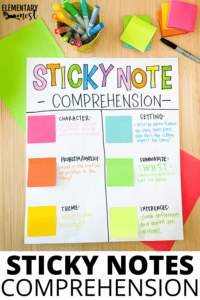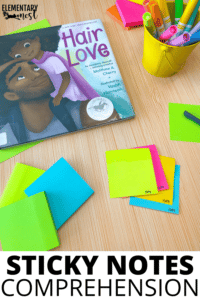
Reading comprehension doesn’t have to be a daunting task. We spend so much time planning, prepping, and curating the perfect comprehension activities for every lesson. However, students can practice their comprehension skills without all the fuss. Use these simple, no-prep sticky note activities to help your students practice and improve their comprehension skills.
Sticky Note Synthesis

Sticky notes are also an excellent tool for the development of critical thinking skills. Asking students to record their inferences and predictions encourages them to pay close attention as they read, think critically about what they’re reading, and remember important details from the text more easily.
As students practice recording their thoughts, they will begin to develop the skill of synthesis. Students will learn to take in new information and process it, allowing it to change or develop the thoughts and understandings they have about a story or text. Being able to synthesize information will greatly improve students’ as whole readers.
Sticky Note Synthesis Prompt Ideas:
- Questions- “I wonder…” “Why/How/When/Where/What…”
- Predictions- “I think ….. will happen next because…” “I predict that …because…”
- Inferences/Drawing Conclusions- “I can infer…because…” “The author did not say… but I can infer that …because…”
- Connections- “This story reminds me of …because…” “This (event, character, story, etc) connects to …because…”
- Synthesis- “I used to think… but now I think…because..”
Sticky Note Story Elements

Another way sticky notes can be useful for reading comprehension is for describing story elements. As stories progress, students can jot down important plot points like characters, settings, events, etc., on individual sticky notes. This helps students keep track of details and important information in order to better understand what’s happening in the story.

This can also be a way for you to check for comprehension. Are students understanding what they are reading? Do they know what the character is like? Do they know what the problem in the story is? You can create a simple anchor chart like the one above. Choose specific colors for each story element and students can practice this sticky note strategy any time they read!
Prompts/Colors Used in the Poster Above:
- Pink- CHARACTER: Describe the main character using two traits. Support with evidence & examples.
- Blue- SETTING: Describe when & where the story takes place. How does the setting impact the events in the story?
- Orange- PROBLEM/CONFLICT: What is the conflict or problem in the story? How do the characters try to solve this?
- Green- PLOT: Summarize the story. SWBST (Somebody-Wanted-But-So-Then)
- Yellow- THEME: What is the theme/message of the story? Support with evidence.
- Neon- INFERENCES: Draw inferences and make predictions.
Context Clues & Vocabulary

Sticky notes can also serve as an effective resource when teaching context clues or unfamiliar words. Students can use sticky notes to record any new vocabulary words that come up during their readings and then use context clues within the text to determine their definitions. The physical act of writing out each word onto its own note helps reinforce its meaning in students’ minds, leading to a better retention rate for new terms encountered during readings.
Not only can this strategy help students learn how to identify and use context clues, but it can also help teachers assess it. You can select a few words from the text that may be unknown or difficult for students. Have them record each word on a separate sticky note. Then, as they read and get to the word, students will develop a definition or synonym based on the surrounding context clues. This encourages critical thinking as well as vocabulary development.
Quick & Sticky Exit Slips

Similarly, sticky notes are excellent exit slips. They are easy to collect and quick to assess. Students can record their answers to exit slip prompts that you provide, either displayed on the board or asked aloud. This is especially helpful when you’re looking for a specific answer that would indicate understanding.
For example, at the end of a lesson on sensory details, you can ask students to list two examples of sensory details from the story on their sticky notes. Or, if you have read an informational text about migration, you can have students explain what migration is on their sticky notes. Any sort of question you would want to ask that would indicate students’ grasping of the concepts you were teaching can be collected on sticky notes!
Tips & Tricks for Using Sticky Notes
Sticky notes are a great tool for teachers to help their students develop stronger reading comprehension skills. Not only can they be used to highlight key points in texts, but they also offer an easy way to draw meaningful inferences and predictions from the text. By writing down key observations or questions on sticky notes, teachers can encourage students to think more deeply about the text and make connections between ideas.

Some Tips & Tricks:
- Put sticky notes on your teacher wishlists (in your newsletter or on your website)
- Have students keep sticky notes in their Book Bins or Reading Tool Kits
- Take a few minutes before a lesson or at the beginning of a week to have students record their names on the back of their sticky notes so that you’re not trying to track down whose is whose
- Keep an extra “sticky note tray” that is closer to the size of sticky notes than regular paper. It will make collecting the sticky notes more organized than having 25 sets of sticky notes stuck all over a paper-sized tray.
- OR You can keep a poster “Parking Lot” on the wall for students to stick their sticky notes to. Simply create a chart with squares for each of the students and they can always leave their sticky notes in that square.
Overall, by taking advantage of this simple but effective learning tool, teachers have the unique opportunity to create an engaging classroom environment where students are encouraged to think deeply about the text and make meaningful connections between ideas. Sticky notes provide a great way for them to practice contextual analysis and hone their critical thinking skills in no time!
No-Prep Comprehension Resources You May Enjoy:


Are you looking for fiction reading comprehension passages and questions to add to your collection? These fiction reading passages are perfect for students to practice their fluency and comprehension skills. With 30 comprehension passages, 4 graphic organizers, AND links to Google Form conversions for each story, you will have a low-prep way to incorporate more comprehension practice in your classroom!















